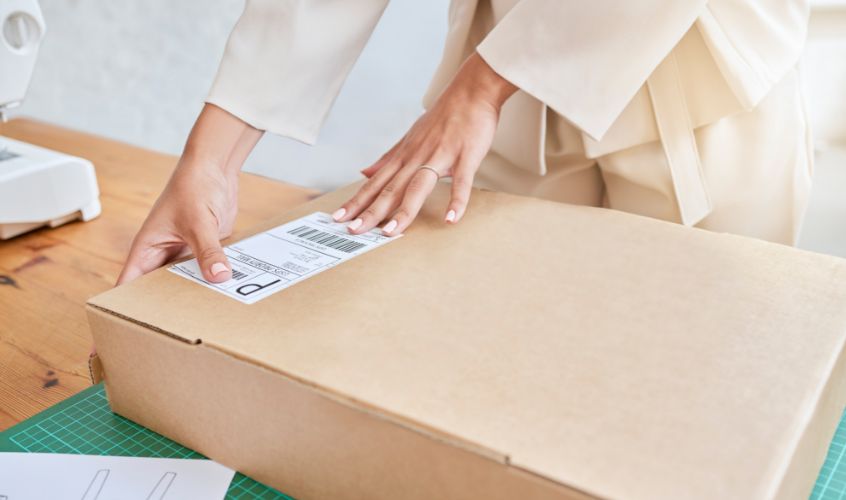Jump To Section
Knowing how to label a box for shipping means the difference between your parcel arriving safely and on time or getting lost. Parcel delivery services do not just require proper labeling, but it’s essential for efficient and safe delivery too. A well-labeled box ensures your package navigates complex logistics networks across cities, countries and continents.
This blog will demystify the labeling process, covering all you need to know to prepare your package for its journey. Whether you’re a first-time sender or a seasoned vendor, understanding how to properly label a box for shipping, what information to include and where to place the label is crucial. We’ll also touch on labeling for fragile items and considerations for international shipments, offering a comprehensive guide that ensures your packages arrive as intended.
Selecting the Right Label
Before we review how to label a box for shipping, let’s discuss the label itself. When it comes to shipping, not all labels are created equal. The label you choose serves as the face of your package, conveying critical information while enduring the rigors of transit. Understanding the types of labels and their specific purposes is the first step in ensuring your package is ready for its journey.
Types of Labels and Their Purposes
Depending on what you’re shipping, you may need a variety of labels:
- Shipping Labels: These are the most common and essential labels, containing all the vital information for shipping, including sender and recipient details, tracking number and barcode. They are the primary way couriers and postal services identify and process packages.
- Fragile Labels: These labels are crucial for items that require gentle handling. Bright and often in bold red or orange, they alert handlers to the delicate nature of the contents.
- Orientation Labels: With symbols like up arrows or “This Side Up” text, these labels help ensure that packages are kept in the correct position throughout their journey, which is particularly important for liquids, electronics and other sensitive items.
Factors When Selecting a Label
When you’re ready to choose a label, think about these considerations:
- Material: The material of your label can significantly impact its durability and visibility. Paper labels are common and cost-effective, while waterproof labels offer more protection against the elements. The choice of material should reflect the shipping conditions and value of the contents.
- Adhesive Type: The strength and type of adhesive are also vital. Some labels come with a strong adhesive back suitable for various surfaces, including corrugated boxes, envelopes and even plastic. Ensure the adhesive is strong enough to stay attached without damaging the package.
- Size: The size of the label should be proportional to the box or item being shipped. It must be large enough to display all necessary information clearly and prominently but not so large that it wraps around edges or folds, which can obscure important details. Some shippers, like Amazon FBA, have stringent requirements about the label size.
Choosing the correct label involves balancing these factors to match the needs of your shipment. Premium Label Supply offers a great selection of blank labels for printing, including thermal labels in various sizes.
Essential Information to Include on a Shipping Label
Knowing how to label a box for shipping means understanding what information to include. To avoid delays, returns or losses, you must provide specific pieces of information that facilitate smooth handling and delivery. Here’s a breakdown of the essential details every shipping label must have:
Sender’s and Recipient’s Full Names and Addresses
Accuracy is key. Include the full name of both the sender and the recipient, along with complete addresses. This includes the street address, city, state and zip code for domestic shipments, and the country for international shipments. Ensure the address is current and formatted correctly to avoid any confusion.
Contact Numbers for Both Sender and Recipient
Providing contact numbers can be a lifesaver in case there’s an issue with the delivery. Couriers or postal services can quickly contact the sender or recipient to resolve any address ambiguities or delivery instructions.
Tracking Number and Barcode
Most shipping services offer a tracking number that should be prominently displayed on the label. This number, often accompanied by a barcode, allows the sender and the recipient to follow the package’s progress. It’s also crucial for logistics providers to manage and sort shipments efficiently.
Weight and Dimensions of the Package
Including the weight and dimensions directly on the label can expedite shipping because it helps carriers determine shipping costs and handling requirements. This is especially important for air transport, where weight and size restrictions are strictly enforced.
Ensuring that your shipping label contains these essential pieces of information can significantly impact the delivery process’s efficiency and security. It aids in the accurate and timely delivery of your package and helps in tracking and resolving any issues that might arise during transit. Taking the time to double-check this information before sending your package is a small step that can prevent a lot of trouble.
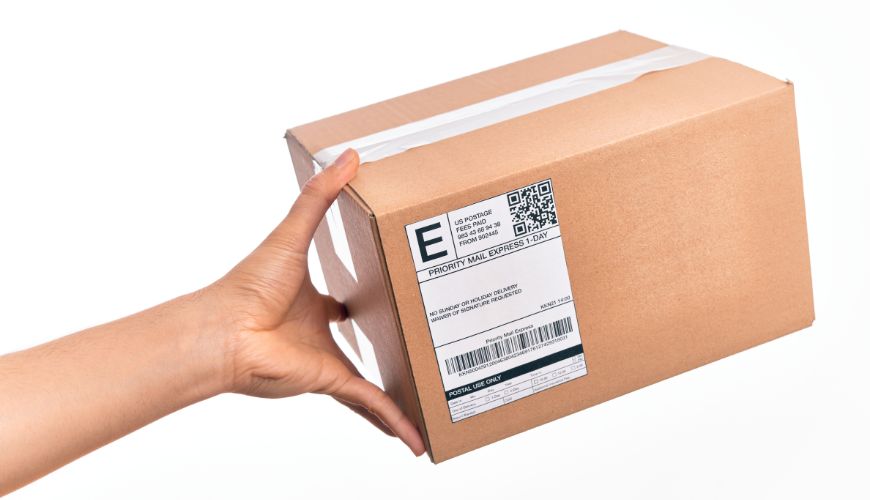
Where to Put a Shipping Label on the Box
Understanding how to properly label a box for shipping is only part of the battle. Knowing where to put the shipping label on the box is just as crucial. The placement of a shipping label on a package is a critical step that can influence the speed and accuracy of delivery. Correct label placement ensures the package is efficiently processed through automated sorting systems. Here are the best practices for label placement and the reasons behind their importance:
On the Largest Surface
You should place the shipping label on the package’s largest surface. This provides ample space for the label to lie flat without bending or wrapping around edges, which can obscure critical information. A flat, unobstructed surface allows barcode scanners and handlers to quickly read the label, reducing the risk of misrouting.
Avoiding Seams or Corners
Labels placed over seams or corners are prone to peeling, tearing or becoming obscured if the box edges get worn out during transit. Ensure the label is set well away from any seams, edges or corners of the box. This precaution helps keep the label intact and readable from the moment it leaves your hands to when it arrives at its destination.
Importance of Visibility and Scannability
The primary reason for adhering to these placement guidelines is to maintain the label’s visibility and scannability. Automated sorting systems in logistics centers use barcode scanners to route packages efficiently. If a label is poorly placed, causing a barcode to be unreadable, it can lead to delays because the package may need to be manually processed. Moreover, visible labels help human handlers quickly identify and sort packages, especially when rerouting or handling exceptions.
Following these label placement practices ensures your package moves smoothly through the delivery network. It’s a simple yet effective way to avoid common shipping pitfalls, helping your package reach its destination on time and in good condition. Always remember, the easier it is to read your label, the smoother the journey for your package.
Preparing Labels for International Shipments
Knowing how to properly label a box for shipping internationally requires a few additional considerations. Here’s how to navigate these requirements to ensure your package not only reaches its destination but also passes through customs smoothly:
Additional Details Required
The label must contain the basic shipping information and customs-related details for international shipments. This includes a detailed description of the contents, the Harmonized System (HS) codes for each item and the country of origin. The HS code is a standardized numerical method of classifying traded products. Customs authorities worldwide use it to assess duties and taxes. The country of origin indicates where the goods were produced, which can affect the applicable tariffs.
Handling Multiple Labels
International shipments often require multiple labels and documents, such as customs declaration forms and commercial invoices. These documents should be securely attached to the outside of the package in a clear plastic sleeve. This ensures customs officials can access the necessary paperwork without opening the package. Ensure the shipping label is visible and not obscured by any additional documents.
Tips on Ensuring Compliance
Follow these recommendations to ensure your label complies with all the proper regulations:
Research Destination Country Regulations
Shipping regulations can vary significantly from one country to another. Research is crucial to understand the destination country’s requirements, including prohibited items, documentation requirements, and other customs regulations.
Accurate and Detailed Content Description
Be precise and thorough when describing the package contents. Vague descriptions like “gift” or “samples” can raise red flags with customs officials and delay your shipment.
Value Declaration
Declare the correct value of the package contents. Lowballing the value to save on taxes and duties is illegal and can result in fines or the seizure of your package.
Use Reliable Shipping Services
Consider using shipping services that are experienced in international logistics and can provide guidance on customs compliance and documentation.
Preparing labels for international shipments requires attention to detail and understanding the complexities of cross-border logistics. The U.S. Post Office provides additional tips on international shipments.
Labeling Fragile Items
Shipping fragile, liquid, or perishable items requires special attention to labeling to ensure they arrive at their destination in the same condition in which they were sent. The use of special labels for these items is not just a courtesy but a necessity to alert handlers that careful attention is required. Here’s how to properly label fragile items for shipping:
Special Labels for Fragile, Liquid or Perishable Items
It’s essential to use labels specifically designed to indicate the nature of the contents. Fragile labels are typically bright and feature the word “FRAGILE” in bold letters, often accompanied by a symbol such as a broken glass or the item in a protective wrapping. Liquid items should be labeled with “LIQUID” to indicate that the package needs to remain upright and may be susceptible to temperature changes or pressure. Perishable items require a “PERISHABLE” label, meaning the contents have a limited shelf life and must be processed quickly and stored under specific conditions.
Placement of Labels for Maximum Visibility
The placement of these special labels is as crucial as their use. To ensure maximum visibility:
- Place labels on the top and sides of the package.
- Avoid placing labels over seams or edges where they can be easily damaged or obscured.
- Use multiple labels if necessary, especially for larger packages, to ensure visibility from every angle.
- The goal is to make it possible for handlers to notice these labels, regardless of how the package is stacked during transit. This visibility is crucial for ensuring your package is handled correctly throughout its journey.
When shipping fragile, liquid or perishable items, the proper labeling ensures the items arrive safely and intact. By clearly marking packages with the appropriate labels and strategically placing them for optimal visibility, you signal the need for special care and handling, minimizing the risk of damage or spoilage.
Frequently Asked Questions About How to Label a Box for Shipping
Premium Label Supply understands your concerns about how to label a box for shipping. We have the expertise and knowledge to answer your labeling questions. Read on to learn more.
Can I Handwrite a Shipping Label?
Yes, you can handwrite a shipping label, but ensure that the handwriting is clear, legible and in permanent ink to withstand handling and weather conditions. Printed labels are preferred for their readability and the inclusion of barcodes for tracking.
What Should I Do If My Package Needs Multiple Labels?
When your package requires multiple labels, such as a shipping label and a fragile label, place the shipping label on the package’s largest surface for visibility. Additional labels like “Fragile” should be placed on the top and sides of the package to ensure they are seen from every angle. Make sure none of the labels overlap or cover important information.
Is It Necessary to Include a Return Address on the Shipping Label?
Yes, including a return address is crucial on the shipping label. It ensures that the package can be returned to you if there are any delivery issues. The return address should be placed in the top left corner of the package or as specified by your chosen shipping carrier’s guidelines.
How Do I Label a Box for International Shipping Differently Than Domestic Shipping?
In addition to the standard shipping label information, you must include customs declaration forms and possibly a commercial invoice for international shipping. These documents should be placed in a clear plastic pouch on the outside of the package. Be sure to list the contents of the package and their value accurately to comply with customs regulations.
What If My Package Is Too Small for All the Required Labels?
Suppose your package is too small to fit all required labels and information clearly. In that case, you may need to use a larger box or attach a larger label pouch that can accommodate the shipping label, any additional labels (like fragile or liquid) and required documents. Ensure all information is visible and that barcodes can be scanned without bending the label.
Order Blank Shipping Labels from Premium Label Supply
Now that you know how to label a box for shipping, you’re ready for the next step. Premium Label Supply offers a fantastic lineup of made-in-the-U.S. blank labels for all your shipping needs. We provide discounts on wholesale orders; you can always count on our outstanding customer service. Shop now and experience the Premium Label Supply difference.
Related Articles
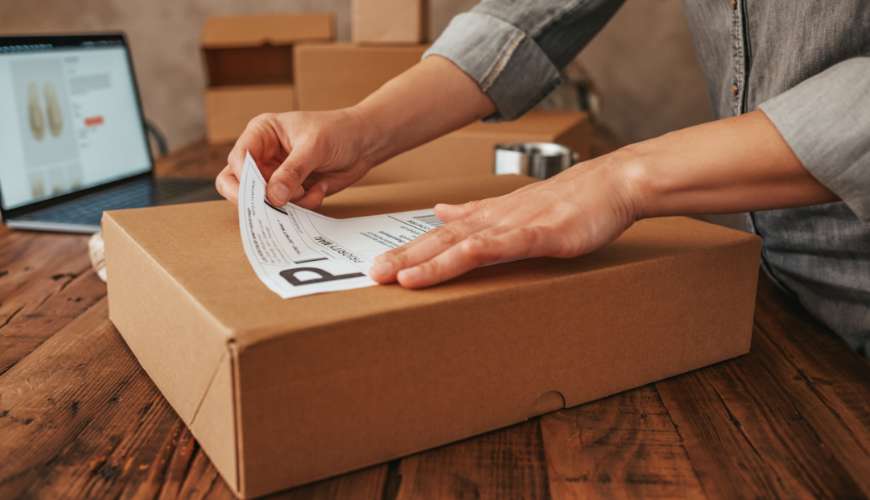
Thermal Transfer vs. Direct Thermal Shipping Labels
DIRECT THERMAL LABELS | March 17, 2023
Learn the difference between direct thermal and thermal transfer shipping labels and when to use each.
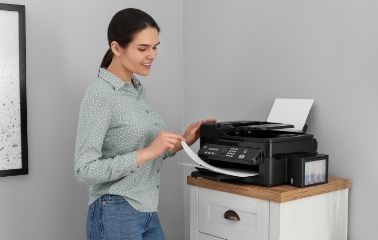
SHIPPING LABELS | January 11, 2024
Discover tips and tricks for successfully printing address labels.
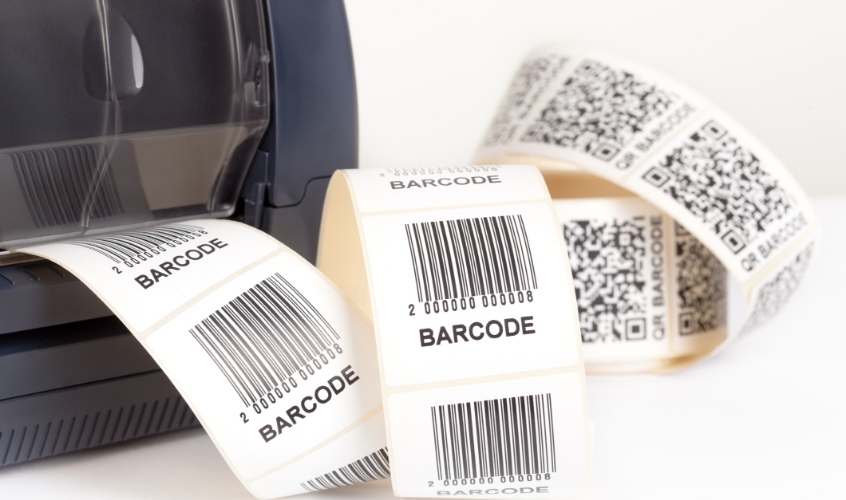
Sheet Labels vs. Roll Labels: The Ultimate Comparison Guide
ROLL, SHEET LABELS | May 8, 2023
See how roll labels differ from sheet labels and what applications are appropriate for each.

